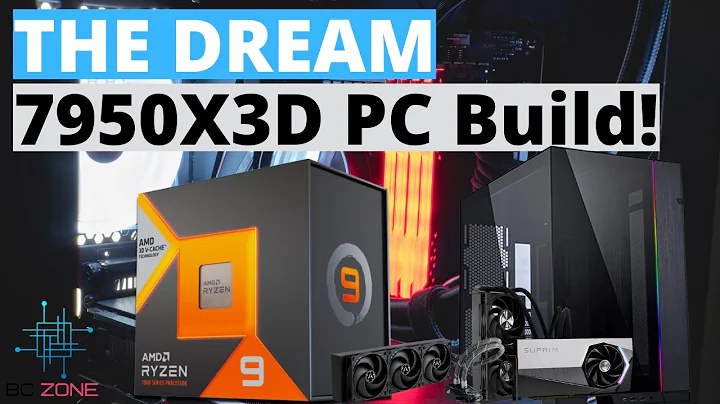Experience the Future of VR with Intel's Project Alloy
Table of Contents:
- Introduction
- Intel's VR Headset: Project Alloy
- Features of Project Alloy
- Merged Reality: A Breakthrough Technology
- Benefits and Advantages of Project Alloy
- The Future of VR Headsets
- Intel's Open Source Approach
- Windows Holographic and Mixed Reality Apps
- Intel and Microsoft Collaboration
- Conclusion
Intel's VR Headset: Project Alloy
Virtual Reality (VR) has become a rapidly growing industry, and Intel is making its mark with their innovative VR headset known as Project Alloy. This wireless VR headset promises to revolutionize the way we experience virtual reality by merging the physical and virtual worlds together. In this article, we will explore the features of Project Alloy, its potential applications, and its impact on the VR industry.
Introduction
Virtual reality has come a long way in recent years, but most VR headsets available in the market require external devices or PC connections to function. However, with Project Alloy, Intel seeks to change this by creating a wireless VR headset that doesn't rely on external power or controllers. The goal is to provide a seamless and immersive VR experience with the headset acting as a standalone device.
Intel's VR Headset: Project Alloy
Project Alloy is Intel's ambitious venture into the VR market. Unveiled at their developer conference in San Francisco, CEO Brian Krzanich introduced this groundbreaking wireless VR headset. Unlike traditional VR headsets, Project Alloy doesn't require a PC or external devices for operation. It is a self-contained device that carries all the necessary computational, graphics, and battery power within itself.
Features of Project Alloy
The highlight of Project Alloy is its ability to merge reality with virtuality. Users can interact with the virtual world using their hands to manipulate real-world objects. For example, a user wearing the Alloy headset could use a dollar bill as a lathe to Shape a virtual block of gold. This merged reality feature opens up endless possibilities for gaming, communication, and work-related tasks.
Additionally, Project Alloy eliminates the need for complex sensor setups and HAND controllers, providing a more convenient and immersive VR experience. The headset comes equipped with built-in 3D cameras and sensors, allowing users to freely navigate and interact in the virtual environment using hand gestures and natural movements.
Merged Reality: A Breakthrough Technology
The concept of merged reality introduced by Project Alloy is a significant step forward in the VR industry. By seamlessly blending real-world objects and virtual elements, users can experience a more realistic and interactive virtual environment. This breakthrough technology addresses one of the main concerns of VR headsets, which is blocking out the real world and potentially endangering users.
By enabling users to see and interact with both the physical and virtual worlds simultaneously, Project Alloy ensures a safer and more engaging VR experience. Tasks like virtual conferencing while still being able to use one's hands for other actions become feasible, providing a truly immersive and productive environment.
Benefits and Advantages of Project Alloy
Project Alloy offers several advantages over traditional VR headsets. Firstly, its wireless nature provides freedom of movement, eliminating the hassle of tangled wires and enhancing overall comfort. The self-contained device reduces reliance on external hardware, simplifying setup and making VR more accessible to a wider audience.
Moreover, the merged reality capability of Project Alloy eliminates the need for external sensors and controllers, reducing costs and enhancing the user experience. This innovative approach opens the doors to a wide range of applications, from gaming to communication to industrial design.
The Future of VR Headsets
With the introduction of Project Alloy, Intel aims to reshape the future of VR headsets. By integrating powerful hardware and merged reality technology into a wireless device, they have set the stage for a new era of immersive virtual reality experiences. The success of Project Alloy depends on developers embracing the platform and creating innovative applications that further enhance the capabilities of the device.
Intel's Open Source Approach
Intel plans to open source the Alloy hardware next year, allowing third-party developers to create their own VR headsets based on Windows 10 and Intel's platform. This open-source approach encourages collaboration and innovation within the VR community. By providing developers with the necessary tools and resources, Intel aims to drive the growth and adoption of VR technology.
Windows Holographic and Mixed Reality Apps
In collaboration with Microsoft, Intel's Project Alloy aligns with the Windows Holographic platform, enabling the seamless integration of mixed reality apps. Developers can create applications that run on Windows 10 PCs and are compatible with various VR and AR headsets. This convergence of technologies provides users with a unified experience across different devices and platforms.
Intel and Microsoft Collaboration
Intel and Microsoft have joined forces to develop specifications for mixed reality-ready PCs and head-mounted displays. This collaboration aims to establish a robust ecosystem for mixed reality by offering a range of hardware options and supporting software. The partnership between Intel and Microsoft further strengthens the prospects of Project Alloy and promotes the growth of the VR industry as a whole.
Conclusion
Project Alloy represents Intel's foray into the VR market, offering a wireless VR headset that combines powerful hardware with merged reality technology. The self-contained device eliminates the need for external equipment and provides a more immersive and interactive VR experience. With an open-source approach and collaboration with Microsoft, Intel aims to drive innovation and accelerate the growth of mixed reality applications. As the VR industry continues to evolve, Project Alloy stands as a significant milestone in the pursuit of seamless and immersive virtual reality experiences.
太长了,可能要删减一下 最好再加一些emoji 标题写的时候注意用段落再写一下
Highlights
- Intel's Project Alloy is a wireless VR headset that merges the real and virtual worlds.
- Project Alloy eliminates the need for external devices, complex sensors, and controllers.
- Merged reality technology allows users to interact with the virtual world using their hands.
- The self-contained device provides a more comfortable and immersive VR experience.
- Intel's open-source approach encourages collaboration and innovation within the VR community.
- Collaboration with Microsoft enables mixed reality apps on Windows 10 PCs and compatible headsets.
FAQ
Q: Does Project Alloy require a PC or external devices?
A: No, Project Alloy is a self-contained VR headset that doesn't need to be plugged into a PC or external devices.
Q: How does merged reality work in Project Alloy?
A: Merged reality allows users to manipulate real-world objects with their hands in the virtual environment, creating a seamless blend of the physical and virtual worlds.
Q: Can Project Alloy be used for work-related tasks?
A: Yes, Project Alloy's merged reality capability makes it suitable for various work-related functions, such as virtual conferencing and interactive design.
Q: Is Project Alloy compatible with other VR platforms?
A: Project Alloy is designed to run on Windows 10 and aligns with the Windows Holographic platform, ensuring compatibility with a range of VR and AR headsets.
Q: When will Project Alloy be available to consumers?
A: Intel has not mentioned a specific release date, but further development is expected throughout late 2017 before the headset becomes widely available.
Q: Will developers be able to create their own VR headsets based on Project Alloy?
A: Yes, Intel plans to open source the Alloy hardware, allowing third-party developers to build their own VR headsets using Intel's platform and resources.
 WHY YOU SHOULD CHOOSE TOOLIFY
WHY YOU SHOULD CHOOSE TOOLIFY

























